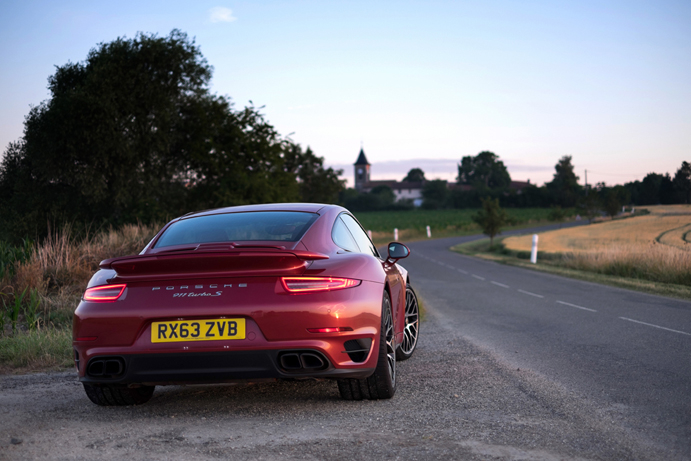

Each of the manufacturers involved in the FIA World Endurance Championship build sports cars to sell to the public. Some are built to a lightweight specification, with weight savings for better acceleration and performance, but without many luxury items – essentially a road going race car. Others are built as the perfect Grand Tourers, with all the latest luxury items and space for luggage that make driving long distances a pleasure but blunt the performance due to the extra weight.
However there are some sports cars that provide luxury and mind blowing performance, with the latest incarnation of the Porsche 911 Turbo S Coupe reportedly being one of those ultimate GT cars.
To put this to the test we drove the 980km from Porsche GB headquarters in Reading across the Channel to the home of the German manufacturer in Stuttgart to take the 911 Turbo S to see where the cars that race with the FIA World Endurance Championship are built and prepared.

Looking at the outside of the 911 Turbo S looks totally familiar as this is the latest incarnation of the Porsche family heritage of the car that stretches back over 50 years. On closer inspection you notice that the Turbo S has a wider and lower stance when compared to other 911s and this profile changes when ‘Sport Plus’ is engaged – but more on that later.
Settling behind the wheel of the 911 you immediately feel at home. Every button, switch and lever is in the right place. The seat is electronically controlled and was very easy to get into a comfortable position for the long drive ahead. The visibility is also very good, both front and rear, with the side mirrors also providing adequate coverage, which was going to be important when driving a right hand drive car on the right in Europe.

The bright red leather interior was punctuated by carbon fibre and aluminium touches, making the cabin a very nice place to sit. The only issue we had with the leather dashboard was in bright sunshine, and we had plenty of that during this trip. The red finish was reflected in the windscreen and was occasionally a little distracting. A black top to the dashboard would’ve made the reflections easier to deal with. But to be honest this is a minor detail and caused more problems for the photography than for the driving experience.
A flick of the key and the 3.8-litre, flat-six, twin turbo engine fires into life. The sound from the exhausts is a little subdued and a little bit disappointing as we were expecting some more drama from the bright red Porsche. However this car has a trick or three up its sleeve and the drama will come later into the trip.

For now we set off from Porsche GB HQ and headed towards Folkestone to catch the Eurotunnel to France. The journey is all motorway and this gave us the opportunity to see what sort of motorway cruiser the 911 is. With ‘Sport Mode’ off, the 7 speed PDK gearbox in ‘Auto’ and ‘Cruise Control’ set to 70mph the Porsche was the consummate luxury car and ate up the miles around the M4 / M25 / M20 motorways, which are possibly the most boring roads in Europe.

The journey through the Eurotunnel was uneventful and thankfully quick and then it was south towards our overnight stop in Metz. The French Auto Route system allowed us to travelling slightly faster than in the UK but again the Cruise Control came into its own, as did the wonderful BOSE sound system installed on the car.
An unexpected bonus of the motorway cruising came at the fuel pump when the 911 returned an average of 28 miles per gallon. For a 560bhp / 197mph supercar this is nothing short of astonishing. Now you don’t buy a £140,000 sports car to save fuel, and most people who own a car like this can afford to run one, but when a litre of Super Unleaded fuel is 1.70€ it is good to know that a 911 is not as thirsty as equivalent cars from other manufacturers.

As the sun began to set over the French countryside we arrived in Metz for the overnight stop, settling down for a good night’s sleep before heading to Germany early the next morning.
Day two dawned to bright sunshine once again and first stop on our itinerary was the Porsche Research and Development facility at Weissach, a short 20-minute drive outside of Stuttgart. The R&D facility at Weissach contains many closely guarded secrets and photography is usually forbidden inside the boundary fence. So it was with great pleasure that we were given permission to photograph the 911 we had driven from the UK alongside the race car outside the motorsport division buildings. We were also privileged to be able to take photographs of the cars inside the LMGTE and LMP1 workshops.


All of the 911 race cars are developed at Weissach and, to date, over 1000 911s have been produced for the track, making Porsche the world’s largest motorsport manufacturer. The latest GT3 Cup cars are housed at Weissach and the GTE spec RSRs are also developed and tested at the facility before being shipped to the two works teams, Porsche Team Manthey in Europe and CORE Autosports in the United States. The LMGTE spec 911 RSR was brought out to be photographed with our road car and the family resemblance is there for all to see, but it is also obvious that the race car sits lower to the ground and has a larger rear wing.

As part of our tour we visited the LMP1 workshop where the 919 hybrids were being worked on after the 24 Hours of Le Mans. The team were desperately disappointed with the result at Le Mans, especially after the no20 car led the race but we mustn't forget that Le Mans was only third race for the German manufacturer since their return to the top class of endurance racing. Looking at the facilities and the resources that Porsche are employing in their effort to win in the FIA World Endurance Championship it isn't difficult to understand why the 919 hybrid finished on the podium in its first race at Silverstone and was leading at Le Mans. They are certainly going to be a force to be reckoned with in the second half of the 2014 season.

After the quick tour of the 919 workshop we headed back to Stuttgart to photograph the 911 Turbo S outside the impressive Porsche Museum in the centre of the city. If you didn’t know that Stuttgart was home of Porsche, you would be left in no doubt when you see the museum and the factory. Again we were given special permission to park the 911 outside the museum on the concourse beneath the mirrored canopy alongside some of the show cars.


After dinner and a quick tour we headed back to Metz for another overnight stop. However on the way back we were able to stretch the legs of the 911 Turbo S Coupe on a quiet piece of the world famous German Autobahn, where there are no speed limits.

By selecting ‘Sport Plus’ mode on the centre console, the 911 changes from a motorway cruiser to an out -and-out performance machine. The gear changes only happen at the red line (7000 rpm), the suspension firms up and the front and rear spoilers extend to change the aerodynamics of the car. There is even a ‘Launch Control’ mode for standing starts that propel the car from 0-62mph in an official time of 3.1 seconds, but this was not for use on the Autobahn !
The performance is staggering and the phenomenal acceleration is seamless as the Porsche Traction Management all-wheel drive system puts all that power onto the road. While on paper the official top speed of 197mph is not quite as fast as other supercars in this class, you don’t really care about +/- 5mph when you are driving the 911 at speed. It is so much fun.

Back into France and, with the 130kph speed limit in force, we returned to a relatively more sedate pace. But before returning to the hotel we decided to find a quiet, straight road to try out the ‘Launch Control’ feature. Selecting ‘Sport Plus’ mode and ‘Drive’ on the PDK gearbox, you hold the car on the brake using your left foot, push the accelerator all the way to the carpet and as the revs rise you let your foot off the brake and the car just takes off. The sensation is like the launch of a jet fighter, you are pushed back into your seat as the 911 hits 60mph in 3 seconds. This is a feature I would like to try at a race track but if anyone says this is ‘just’ a 911, they need to be strapped into this car and experience the acceleration with Launch Control selected.

After another good night’s sleep we headed out early to get some photographs of the car as the sun came up and to give the car a run on the country roads in ‘Sport’ mode. The grin inducing performance around the twisty roads was enough to convince us that the Porsche 911 Turbo S is the consummate all-round GT car that we were told it was.
We then began the long journey back to Calais to catch the Eurotunnel back to England. Once again the Porsche 911 Turbo S ate up the motorway miles with ease and we arrived back in Calais in good time to catch the train. The journey back to Reading from Folkestone proved to be just as easy and we arrived back to hand over the keys to Porsche GB refreshed and without any issues of cramp or back pain that are sometimes associated with long journeys in sports cars.

We set out to see if the Porsche 911 Turbo S was the perfect GT car. After three days, and driving for over 2000km, we can conclude that the 911 Turbo S offers Grand Touring luxury AND spectacular performance in one complete package.






If you missed the previous articles on the Aston Martin V12 Vantage S and the Audi R8 click the links below
Aston Martin V12 Vantage S V12 Audi R8
Words and photography by Jeff Carter / MacLean Photographic